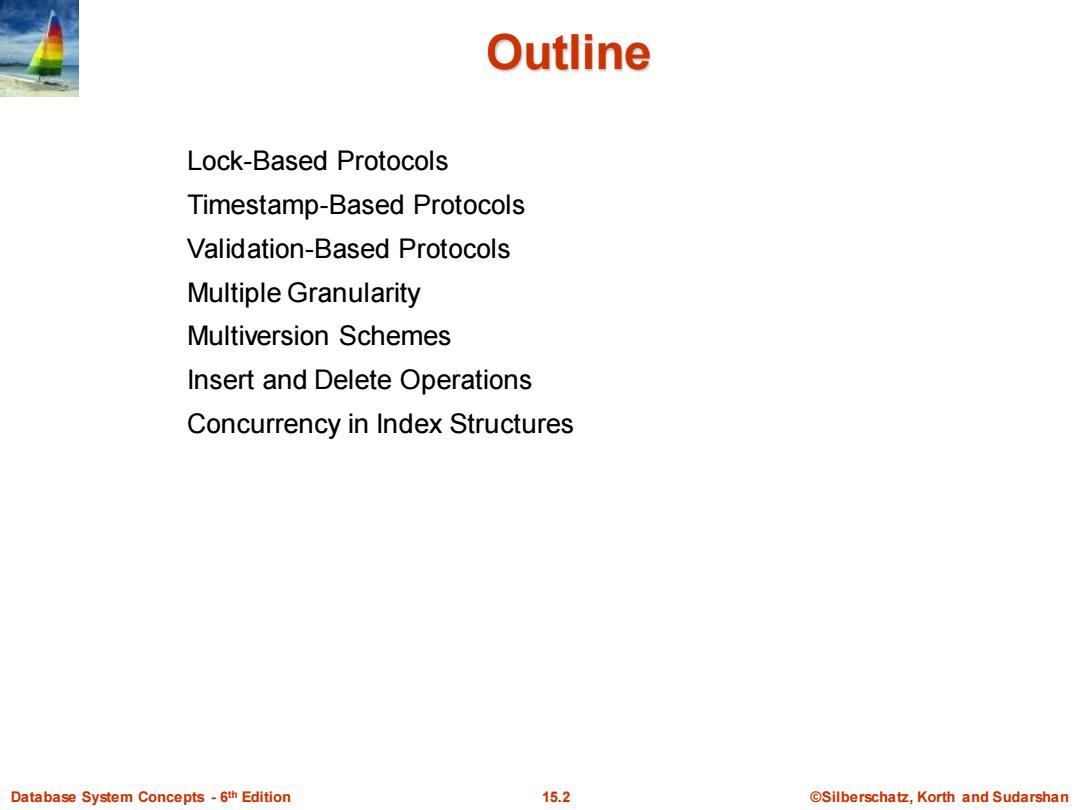
Outline Lock-Based Protocols Timestamp-Based Protocols Validation-Based Protocols Multiple Granularity Multiversion Schemes Insert and Delete Operations Concurrency in Index Structures Database System Concepts-6th Edition 15.2 @Silberschatz,Korth and Sudarshan
Database System Concepts - 6 15.2 ©Silberschatz, Korth and Sudarshan th Edition Outline Lock-Based Protocols Timestamp-Based Protocols Validation-Based Protocols Multiple Granularity Multiversion Schemes Insert and Delete Operations Concurrency in Index Structures
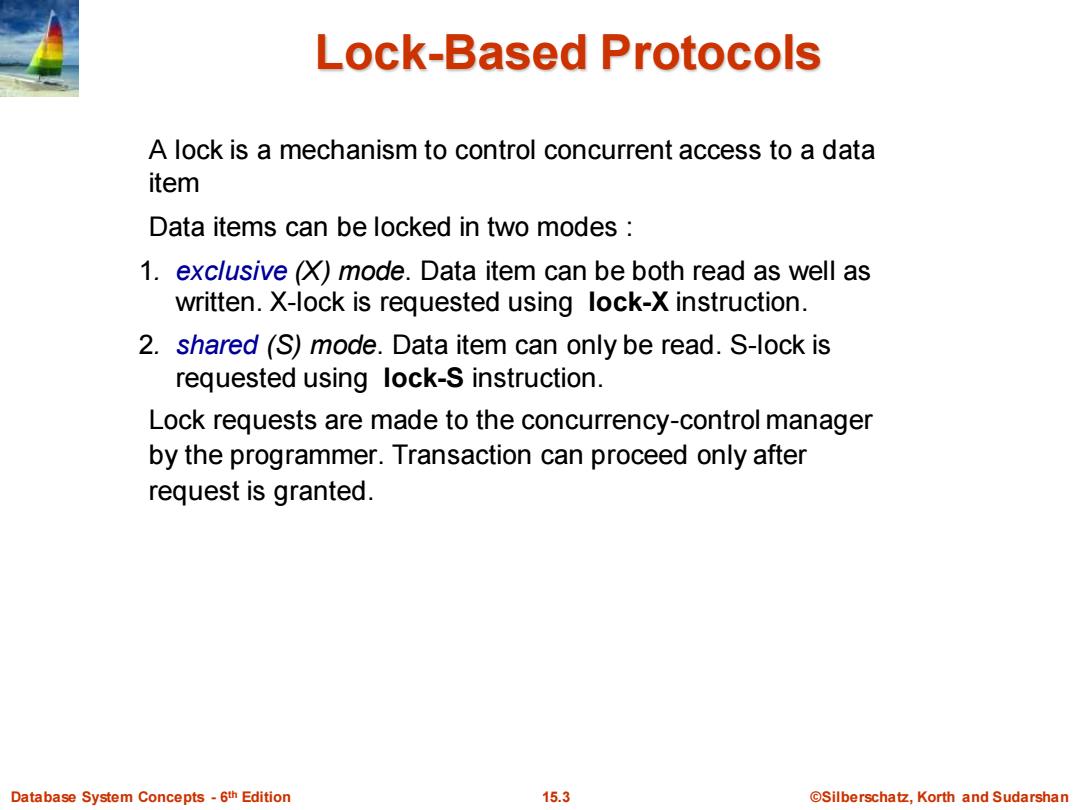
Lock-Based Protocols A lock is a mechanism to control concurrent access to a data item Data items can be locked in two modes 1.exclusive ()mode.Data item can be both read as well as written.X-lock is requested using lock-X instruction. 2.shared(S)mode.Data item can only be read.S-lock is requested using lock-S instruction. Lock requests are made to the concurrency-control manager by the programmer.Transaction can proceed only after request is granted. Database System Concepts-6th Edition 15.3 @Silberschatz,Korth and Sudarshan
Database System Concepts - 6 15.3 ©Silberschatz, Korth and Sudarshan th Edition Lock-Based Protocols A lock is a mechanism to control concurrent access to a data item Data items can be locked in two modes : 1. exclusive (X) mode. Data item can be both read as well as written. X-lock is requested using lock-X instruction. 2. shared (S) mode. Data item can only be read. S-lock is requested using lock-S instruction. Lock requests are made to the concurrency-control manager by the programmer. Transaction can proceed only after request is granted
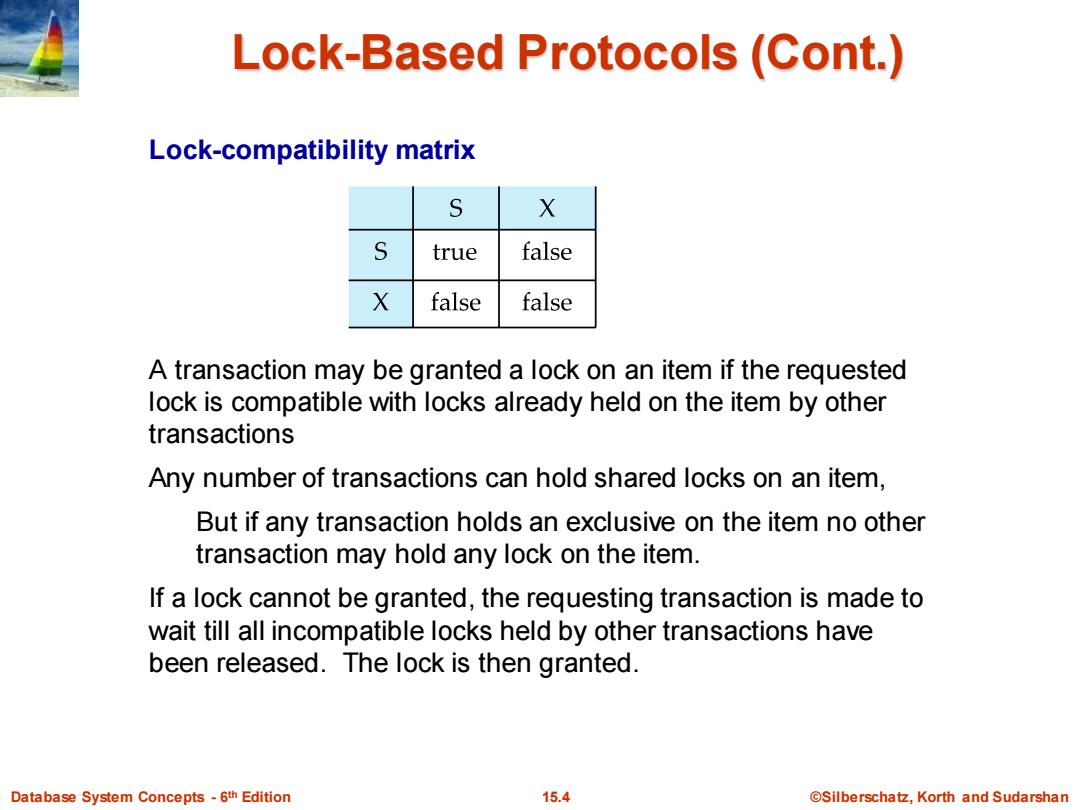
Lock-Based Protocols (Cont.) Lock-compatibility matrix S X S true false X false false A transaction may be granted a lock on an item if the requested lock is compatible with locks already held on the item by other transactions Any number of transactions can hold shared locks on an item, But if any transaction holds an exclusive on the item no other transaction may hold any lock on the item. If a lock cannot be granted,the requesting transaction is made to wait till all incompatible locks held by other transactions have been released.The lock is then granted. Database System Concepts-6th Edition 15.4 ©Silberschat乜,Korth and Sudarshan
Database System Concepts - 6 15.4 ©Silberschatz, Korth and Sudarshan th Edition Lock-Based Protocols (Cont.) Lock-compatibility matrix A transaction may be granted a lock on an item if the requested lock is compatible with locks already held on the item by other transactions Any number of transactions can hold shared locks on an item, But if any transaction holds an exclusive on the item no other transaction may hold any lock on the item. If a lock cannot be granted, the requesting transaction is made to wait till all incompatible locks held by other transactions have been released. The lock is then granted
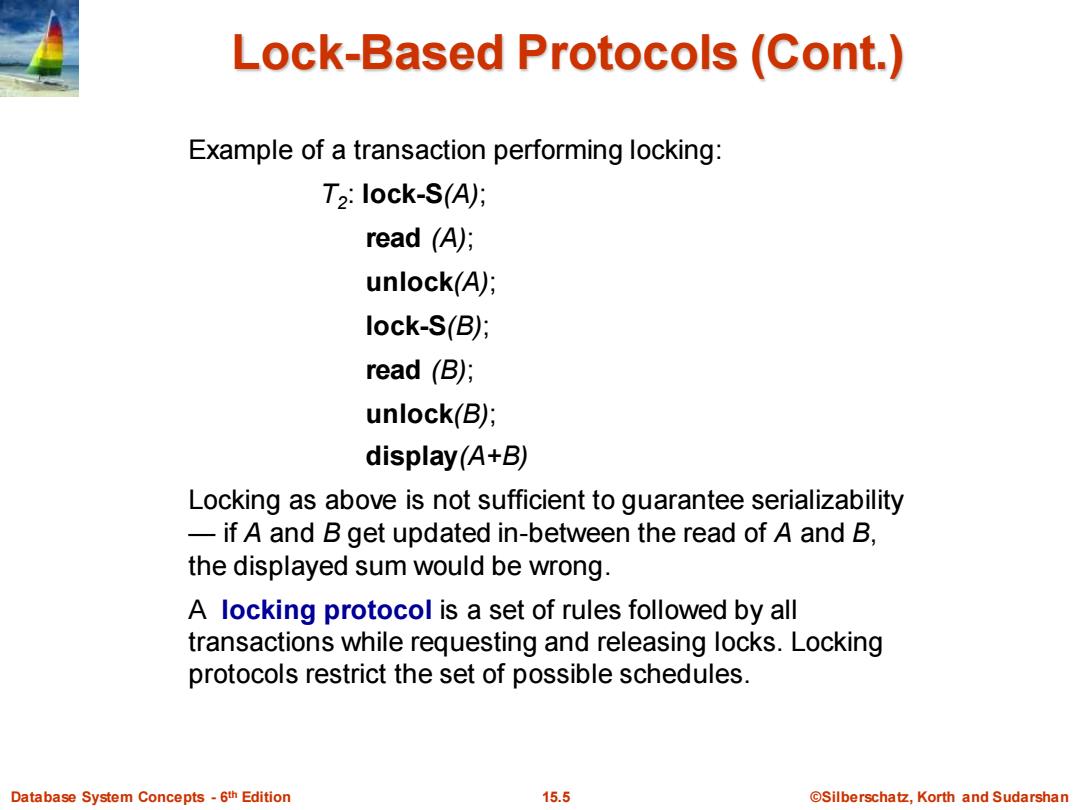
Lock-Based Protocols (Cont.) Example of a transaction performing locking: T2:lock-S(A); read (A); unlock(A); lock-S(B); read (B); unlock(B); display(A+B) Locking as above is not sufficient to guarantee serializability -if A and B get updated in-between the read of A and B, the displayed sum would be wrong. A locking protocol is a set of rules followed by all transactions while requesting and releasing locks.Locking protocols restrict the set of possible schedules. Database System Concepts-6th Edition 15.5 ©Silberschat乜,Korth and Sudarshan
Database System Concepts - 6 15.5 ©Silberschatz, Korth and Sudarshan th Edition Lock-Based Protocols (Cont.) Example of a transaction performing locking: T2 : lock-S(A); read (A); unlock(A); lock-S(B); read (B); unlock(B); display(A+B) Locking as above is not sufficient to guarantee serializability — if A and B get updated in-between the read of A and B, the displayed sum would be wrong. A locking protocol is a set of rules followed by all transactions while requesting and releasing locks. Locking protocols restrict the set of possible schedules
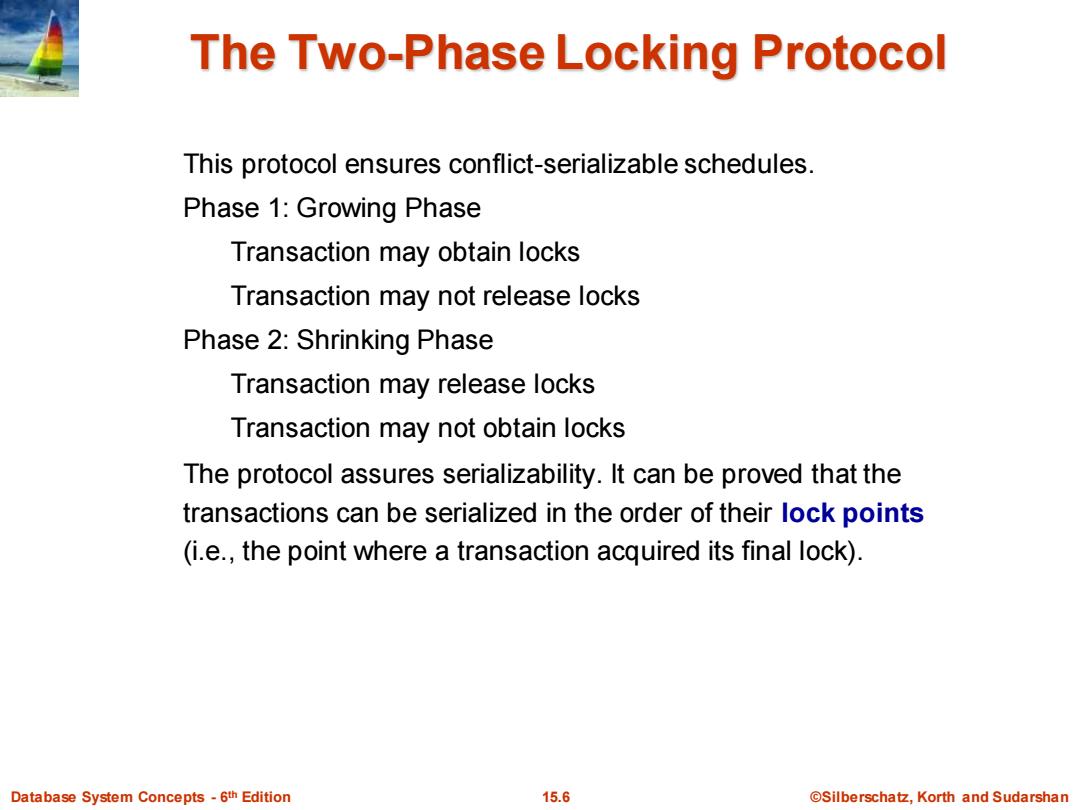
The Two-Phase Locking Protocol This protocol ensures conflict-serializable schedules. Phase 1:Growing Phase Transaction may obtain locks Transaction may not release locks Phase 2:Shrinking Phase Transaction may release locks Transaction may not obtain locks The protocol assures serializability.It can be proved that the transactions can be serialized in the order of their lock points (i.e.,the point where a transaction acquired its final lock). Database System Concepts-6th Edition 15.6 @Silberschatz,Korth and Sudarshan
Database System Concepts - 6 15.6 ©Silberschatz, Korth and Sudarshan th Edition The Two-Phase Locking Protocol This protocol ensures conflict-serializable schedules. Phase 1: Growing Phase Transaction may obtain locks Transaction may not release locks Phase 2: Shrinking Phase Transaction may release locks Transaction may not obtain locks The protocol assures serializability. It can be proved that the transactions can be serialized in the order of their lock points (i.e., the point where a transaction acquired its final lock)
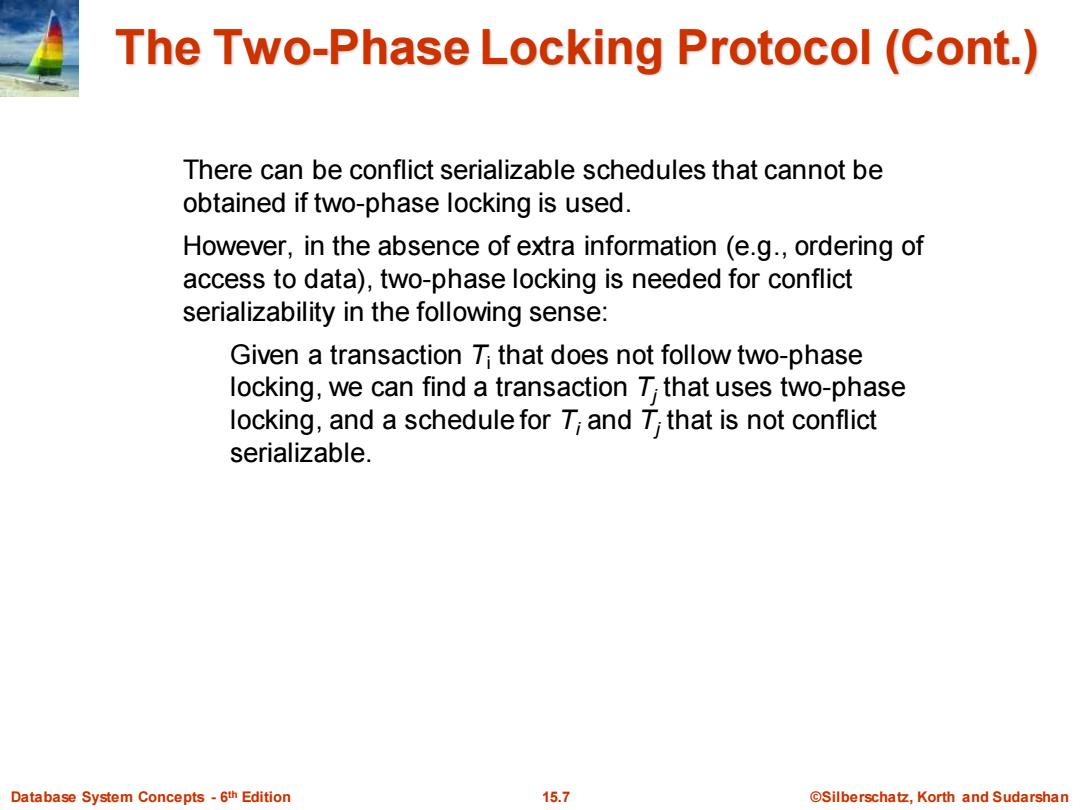
The Two-Phase Locking Protocol (Cont.) There can be conflict serializable schedules that cannot be obtained if two-phase locking is used. However,in the absence of extra information (e.g.,ordering of access to data),two-phase locking is needed for conflict serializability in the following sense: Given a transaction Ti that does not follow two-phase locking,we can find a transaction T that uses two-phase locking,and a schedule for T;and T;that is not conflict serializable. Database System Concepts-6th Edition 15.7 @Silberschatz,Korth and Sudarshan
Database System Concepts - 6 15.7 ©Silberschatz, Korth and Sudarshan th Edition The Two-Phase Locking Protocol (Cont.) There can be conflict serializable schedules that cannot be obtained if two-phase locking is used. However, in the absence of extra information (e.g., ordering of access to data), two-phase locking is needed for conflict serializability in the following sense: Given a transaction Ti that does not follow two-phase locking, we can find a transaction Tj that uses two-phase locking, and a schedule for Ti and Tj that is not conflict serializable
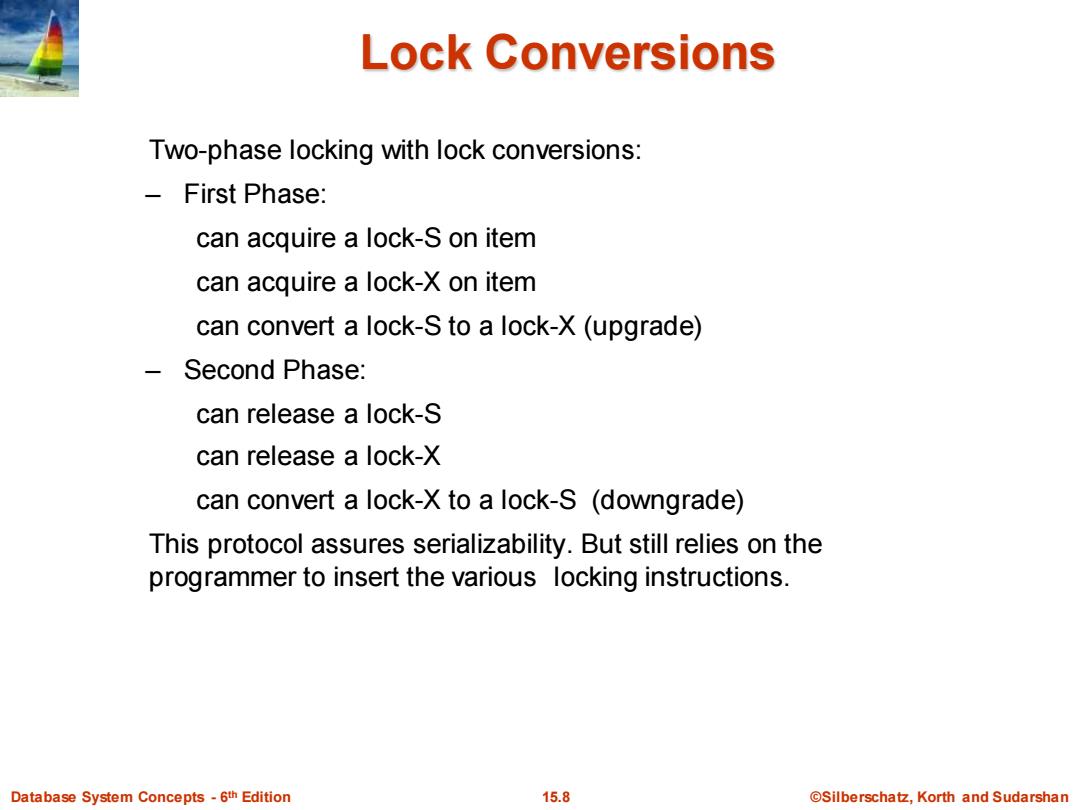
Lock Conversions Two-phase locking with lock conversions: First Phase: can acquire a lock-S on item can acquire a lock-X on item can convert a lock-S to a lock-X (upgrade) -Second Phase: can release a lock-S can release a lock-X can convert a lock-X to a lock-S (downgrade) This protocol assures serializability.But still relies on the programmer to insert the various locking instructions. Database System Concepts-6th Edition 15.8 @Silberschatz,Korth and Sudarshan
Database System Concepts - 6 15.8 ©Silberschatz, Korth and Sudarshan th Edition Lock Conversions Two-phase locking with lock conversions: – First Phase: can acquire a lock-S on item can acquire a lock-X on item can convert a lock-S to a lock-X (upgrade) – Second Phase: can release a lock-S can release a lock-X can convert a lock-X to a lock-S (downgrade) This protocol assures serializability. But still relies on the programmer to insert the various locking instructions
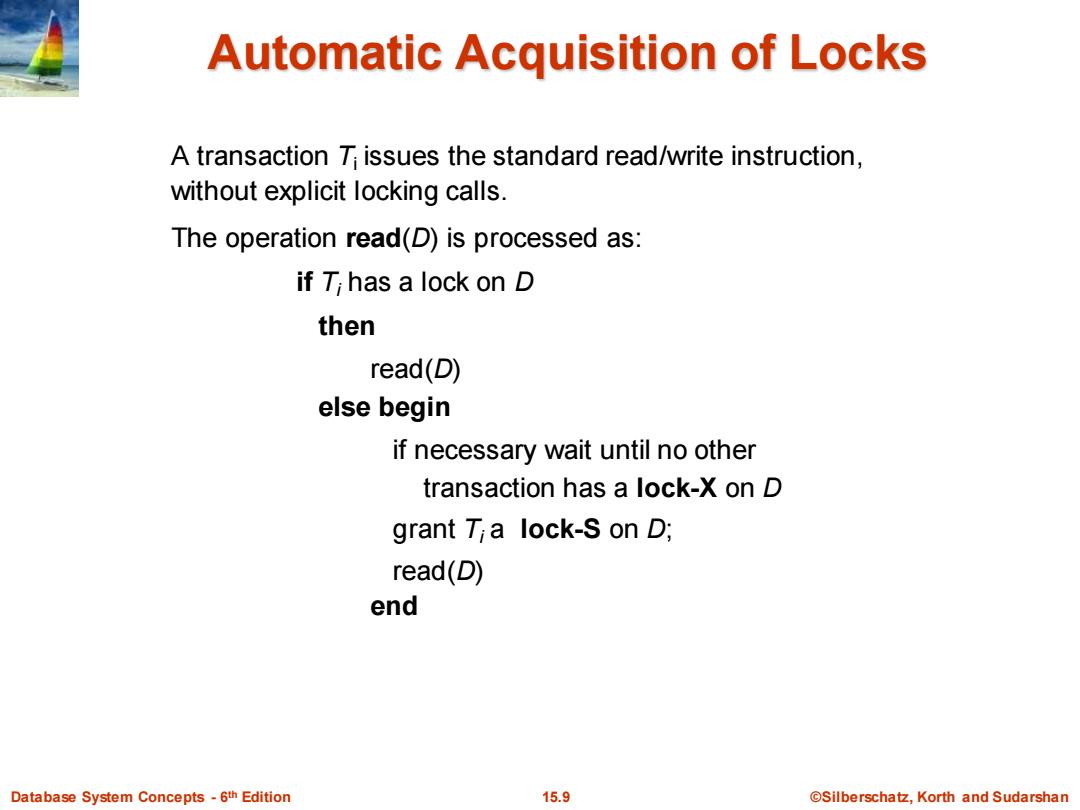
Automatic Acquisition of Locks A transaction T issues the standard read/write instruction, without explicit locking calls. The operation read(D)is processed as: if T;has a lock on D then read(D) else begin if necessary wait until no other transaction has a lock-X on D grant Tia lock-S on D; read(D) end Database System Concepts-6th Edition 15.9 @Silberschatz,Korth and Sudarshan
Database System Concepts - 6 15.9 ©Silberschatz, Korth and Sudarshan th Edition Automatic Acquisition of Locks A transaction Ti issues the standard read/write instruction, without explicit locking calls. The operation read(D) is processed as: if Ti has a lock on D then read(D) else begin if necessary wait until no other transaction has a lock-X on D grant Ti a lock-S on D; read(D) end
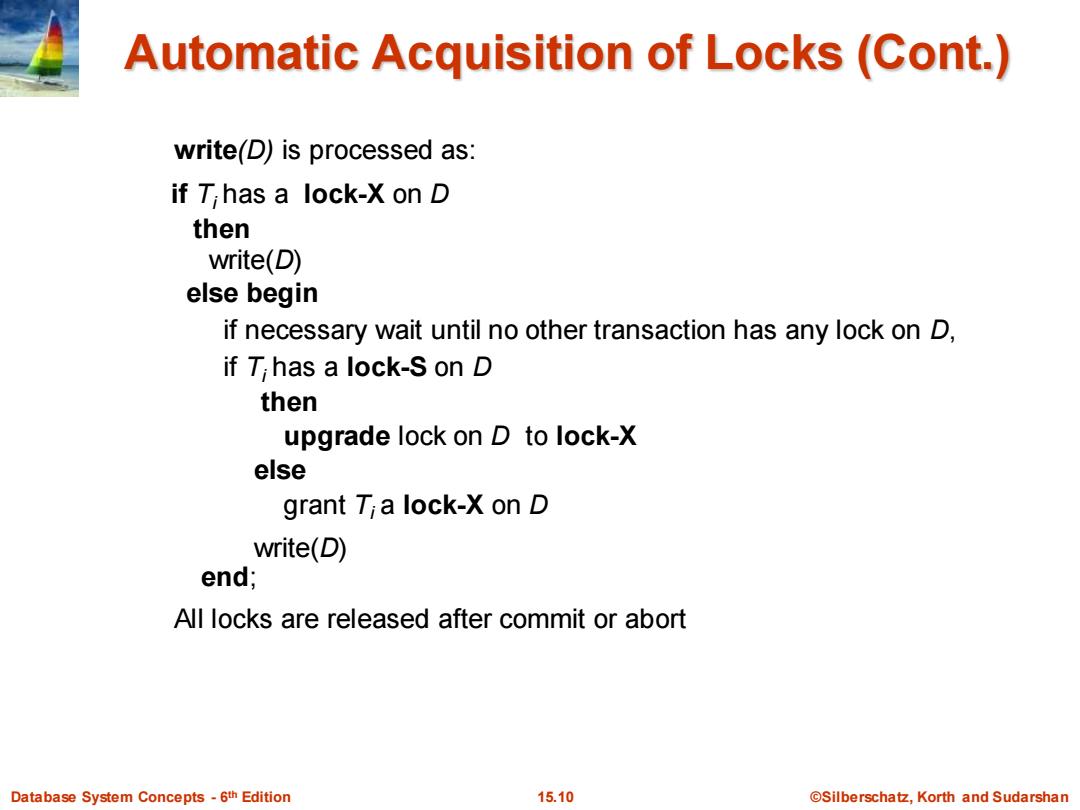
Automatic Acquisition of Locks (Cont.) write(D)is processed as: if T;has a lock-X on D then write(D) else begin if necessary wait until no other transaction has any lock on D, if T;has a lock-S on D then upgrade lock on D to lock-X else grant Tia lock-X on D write(D) end; All locks are released after commit or abort Database System Concepts-6th Edition 15.10 @Silberschatz,Korth and Sudarshan
Database System Concepts - 6 15.10 ©Silberschatz, Korth and Sudarshan th Edition Automatic Acquisition of Locks (Cont.) write(D) is processed as: if Ti has a lock-X on D then write(D) else begin if necessary wait until no other transaction has any lock on D, if Ti has a lock-S on D then upgrade lock on D to lock-X else grant Ti a lock-X on D write(D) end; All locks are released after commit or abort
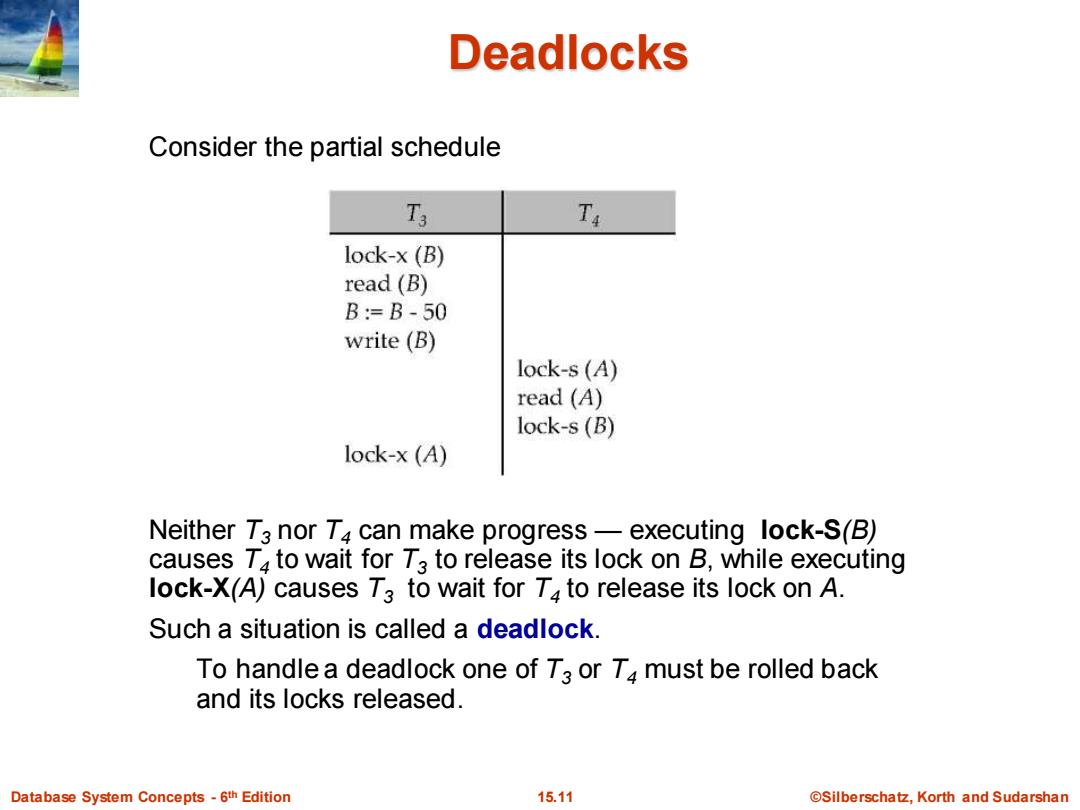
Deadlocks Consider the partial schedule Ta Ta lock-x (B) read (B) B=B-50 write (B) lock-s (A) read (A) lock-s (B) lock-x (A) Neither T3 nor T4 can make progress-executing lock-S(B) causes T4 to wait for T3 to release its lock on B,while executing lock-X(A)causes T3 to wait for T4 to release its lock on A. Such a situation is called a deadlock. To handle a deadlock one of T3 or T4 must be rolled back and its locks released. Database System Concepts-6th Edition 15.11 ©Silberschat乜,Korth and Sudarshan
Database System Concepts - 6 15.11 ©Silberschatz, Korth and Sudarshan th Edition Deadlocks Consider the partial schedule Neither T3 nor T4 can make progress — executing lock-S(B) causes T4 to wait for T3 to release its lock on B, while executing lock-X(A) causes T3 to wait for T4 to release its lock on A. Such a situation is called a deadlock. To handle a deadlock one of T3 or T4 must be rolled back and its locks released